Comprehensive Report on Human Resource Management in the NHS Hospital
VerifiedAdded on 2019/12/03
|16
|3797
|136
Report
AI Summary
This report delves into the intricacies of human resource management within the National Health Service (NHS) hospital system. It begins by outlining the factors crucial for effective recruitment of healthcare professionals, including doctors, nurses, and support staff, emphasizing the importance of broad recruitment policies and adherence to legislative frameworks. The report then explores team dynamics, analyzing how individuals interact in groups and evaluating approaches for fostering effective team working, including strategies for staff development and promotion. Furthermore, the report examines performance monitoring methods, identifies individual training and development needs, and analyzes strategies for promoting continuous professional development within the healthcare workplace. The report provides a comprehensive overview of key HR practices in the NHS, offering insights into the challenges and opportunities within the health and social care sector.

Paraphrase This Document
Need a fresh take? Get an instant paraphrase of this document with our AI Paraphraser
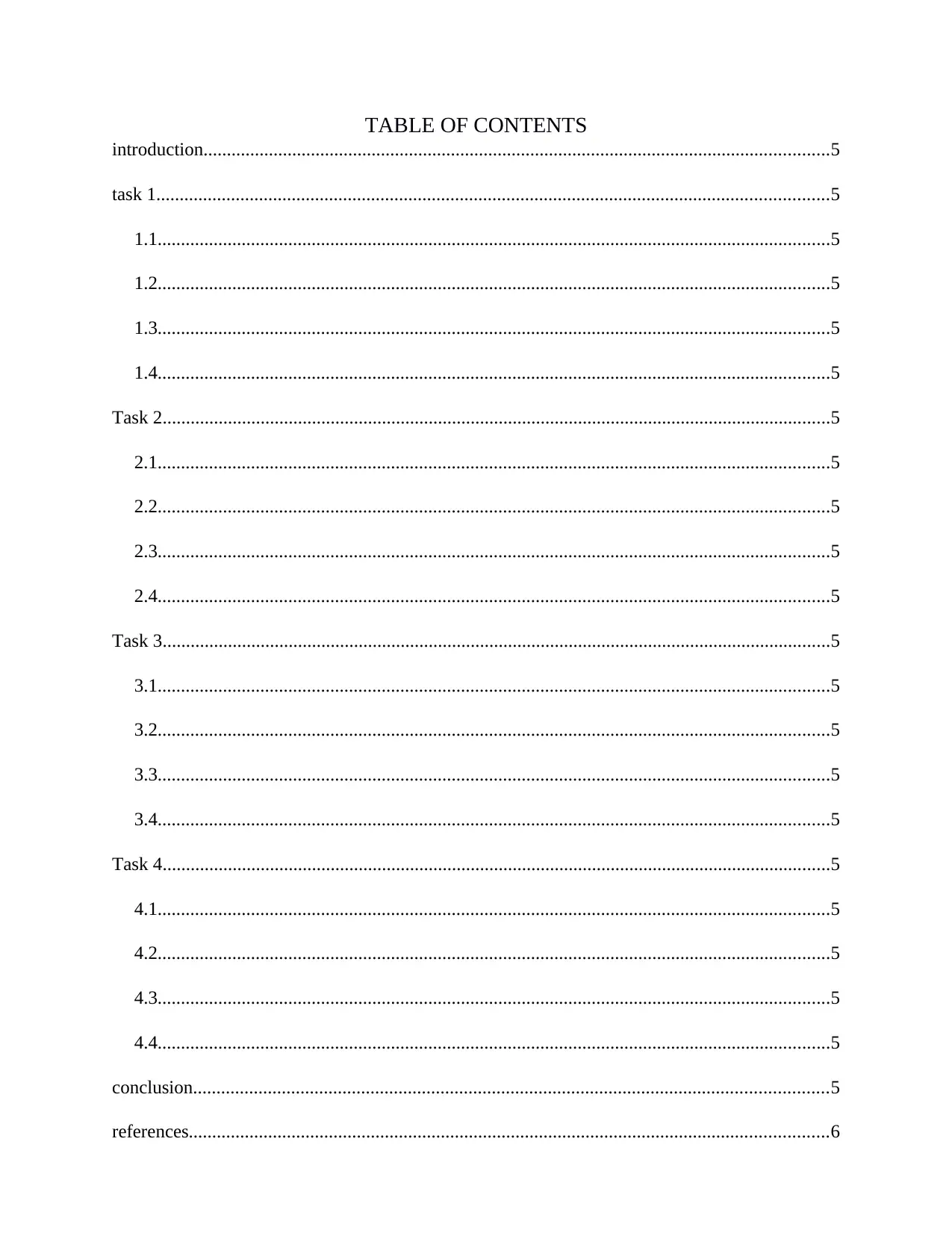
TABLE OF CONTENTS
introduction......................................................................................................................................5
task 1................................................................................................................................................5
1.1................................................................................................................................................5
1.2................................................................................................................................................5
1.3................................................................................................................................................5
1.4................................................................................................................................................5
Task 2...............................................................................................................................................5
2.1................................................................................................................................................5
2.2................................................................................................................................................5
2.3................................................................................................................................................5
2.4................................................................................................................................................5
Task 3...............................................................................................................................................5
3.1................................................................................................................................................5
3.2................................................................................................................................................5
3.3................................................................................................................................................5
3.4................................................................................................................................................5
Task 4...............................................................................................................................................5
4.1................................................................................................................................................5
4.2................................................................................................................................................5
4.3................................................................................................................................................5
4.4................................................................................................................................................5
conclusion........................................................................................................................................5
references.........................................................................................................................................6
introduction......................................................................................................................................5
task 1................................................................................................................................................5
1.1................................................................................................................................................5
1.2................................................................................................................................................5
1.3................................................................................................................................................5
1.4................................................................................................................................................5
Task 2...............................................................................................................................................5
2.1................................................................................................................................................5
2.2................................................................................................................................................5
2.3................................................................................................................................................5
2.4................................................................................................................................................5
Task 3...............................................................................................................................................5
3.1................................................................................................................................................5
3.2................................................................................................................................................5
3.3................................................................................................................................................5
3.4................................................................................................................................................5
Task 4...............................................................................................................................................5
4.1................................................................................................................................................5
4.2................................................................................................................................................5
4.3................................................................................................................................................5
4.4................................................................................................................................................5
conclusion........................................................................................................................................5
references.........................................................................................................................................6
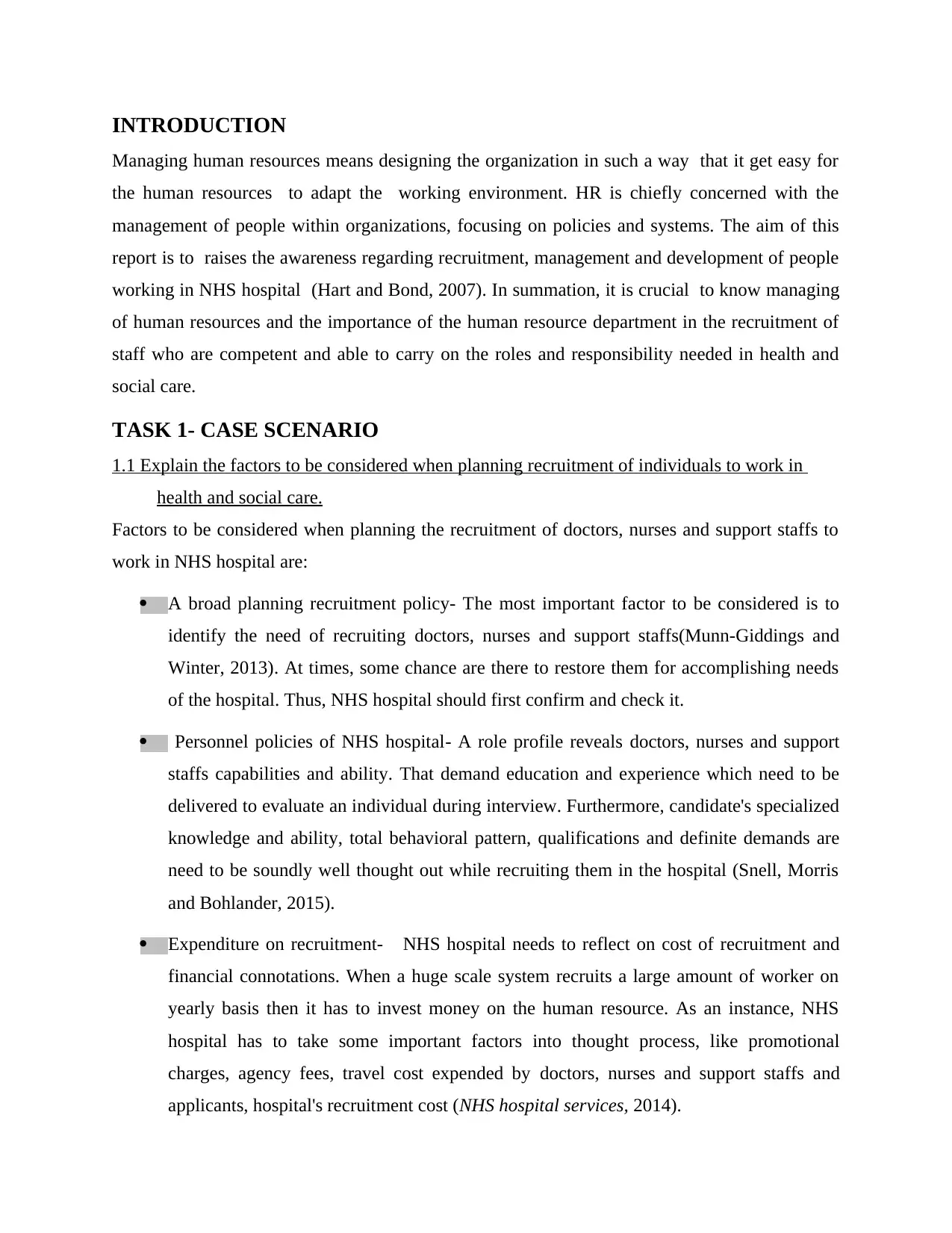
INTRODUCTION
Managing human resources means designing the organization in such a way that it get easy for
the human resources to adapt the working environment. HR is chiefly concerned with the
management of people within organizations, focusing on policies and systems. The aim of this
report is to raises the awareness regarding recruitment, management and development of people
working in NHS hospital (Hart and Bond, 2007). In summation, it is crucial to know managing
of human resources and the importance of the human resource department in the recruitment of
staff who are competent and able to carry on the roles and responsibility needed in health and
social care.
TASK 1- CASE SCENARIO
1.1 Explain the factors to be considered when planning recruitment of individuals to work in
health and social care.
Factors to be considered when planning the recruitment of doctors, nurses and support staffs to
work in NHS hospital are:
A broad planning recruitment policy- The most important factor to be considered is to
identify the need of recruiting doctors, nurses and support staffs(Munn-Giddings and
Winter, 2013). At times, some chance are there to restore them for accomplishing needs
of the hospital. Thus, NHS hospital should first confirm and check it.
Personnel policies of NHS hospital- A role profile reveals doctors, nurses and support
staffs capabilities and ability. That demand education and experience which need to be
delivered to evaluate an individual during interview. Furthermore, candidate's specialized
knowledge and ability, total behavioral pattern, qualifications and definite demands are
need to be soundly well thought out while recruiting them in the hospital (Snell, Morris
and Bohlander, 2015).
Expenditure on recruitment- NHS hospital needs to reflect on cost of recruitment and
financial connotations. When a huge scale system recruits a large amount of worker on
yearly basis then it has to invest money on the human resource. As an instance, NHS
hospital has to take some important factors into thought process, like promotional
charges, agency fees, travel cost expended by doctors, nurses and support staffs and
applicants, hospital's recruitment cost (NHS hospital services, 2014).
Managing human resources means designing the organization in such a way that it get easy for
the human resources to adapt the working environment. HR is chiefly concerned with the
management of people within organizations, focusing on policies and systems. The aim of this
report is to raises the awareness regarding recruitment, management and development of people
working in NHS hospital (Hart and Bond, 2007). In summation, it is crucial to know managing
of human resources and the importance of the human resource department in the recruitment of
staff who are competent and able to carry on the roles and responsibility needed in health and
social care.
TASK 1- CASE SCENARIO
1.1 Explain the factors to be considered when planning recruitment of individuals to work in
health and social care.
Factors to be considered when planning the recruitment of doctors, nurses and support staffs to
work in NHS hospital are:
A broad planning recruitment policy- The most important factor to be considered is to
identify the need of recruiting doctors, nurses and support staffs(Munn-Giddings and
Winter, 2013). At times, some chance are there to restore them for accomplishing needs
of the hospital. Thus, NHS hospital should first confirm and check it.
Personnel policies of NHS hospital- A role profile reveals doctors, nurses and support
staffs capabilities and ability. That demand education and experience which need to be
delivered to evaluate an individual during interview. Furthermore, candidate's specialized
knowledge and ability, total behavioral pattern, qualifications and definite demands are
need to be soundly well thought out while recruiting them in the hospital (Snell, Morris
and Bohlander, 2015).
Expenditure on recruitment- NHS hospital needs to reflect on cost of recruitment and
financial connotations. When a huge scale system recruits a large amount of worker on
yearly basis then it has to invest money on the human resource. As an instance, NHS
hospital has to take some important factors into thought process, like promotional
charges, agency fees, travel cost expended by doctors, nurses and support staffs and
applicants, hospital's recruitment cost (NHS hospital services, 2014).
⊘ This is a preview!⊘
Do you want full access?
Subscribe today to unlock all pages.

Trusted by 1+ million students worldwide
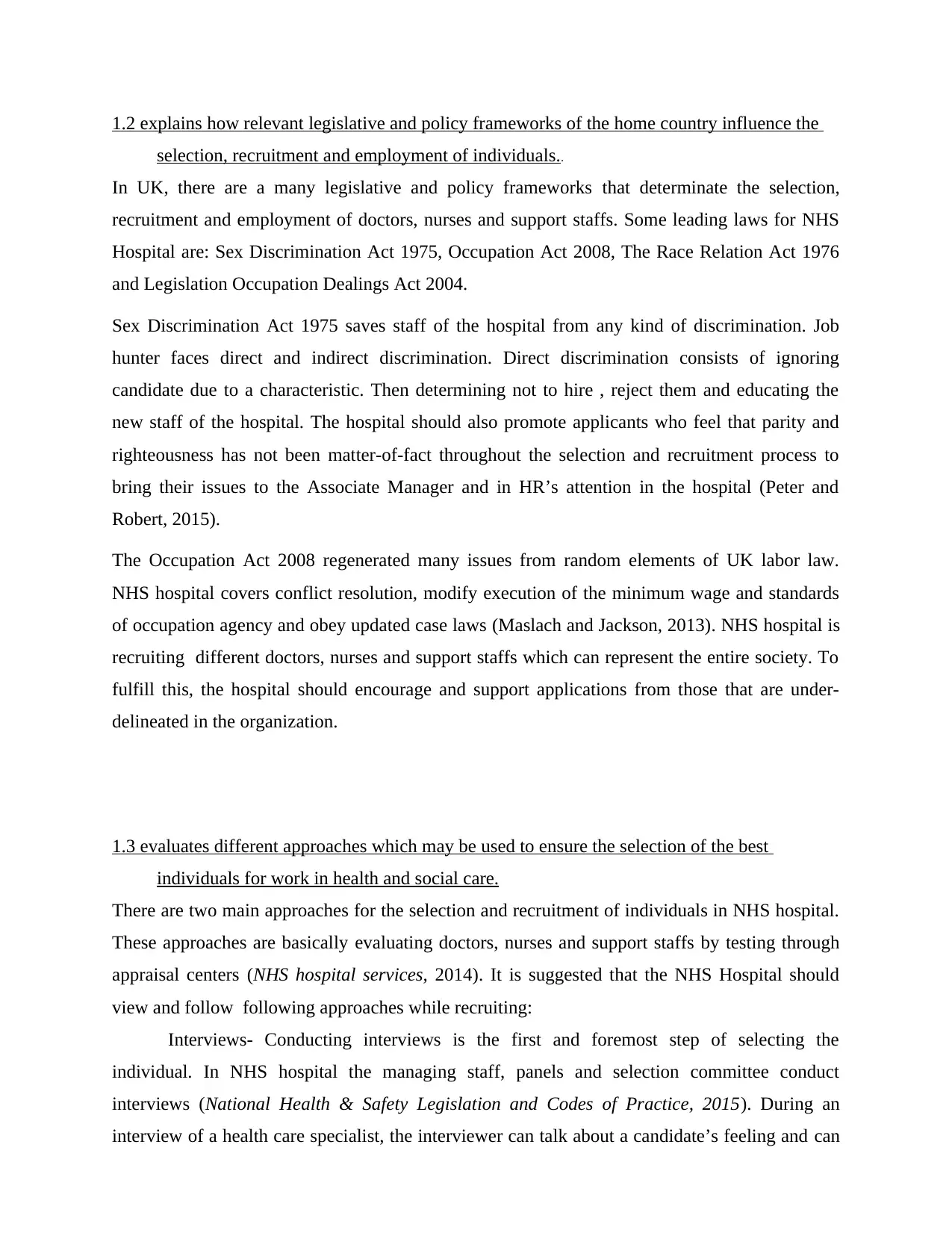
1.2 explains how relevant legislative and policy frameworks of the home country influence the
selection, recruitment and employment of individuals..
In UK, there are a many legislative and policy frameworks that determinate the selection,
recruitment and employment of doctors, nurses and support staffs. Some leading laws for NHS
Hospital are: Sex Discrimination Act 1975, Occupation Act 2008, The Race Relation Act 1976
and Legislation Occupation Dealings Act 2004.
Sex Discrimination Act 1975 saves staff of the hospital from any kind of discrimination. Job
hunter faces direct and indirect discrimination. Direct discrimination consists of ignoring
candidate due to a characteristic. Then determining not to hire , reject them and educating the
new staff of the hospital. The hospital should also promote applicants who feel that parity and
righteousness has not been matter-of-fact throughout the selection and recruitment process to
bring their issues to the Associate Manager and in HR’s attention in the hospital (Peter and
Robert, 2015).
The Occupation Act 2008 regenerated many issues from random elements of UK labor law.
NHS hospital covers conflict resolution, modify execution of the minimum wage and standards
of occupation agency and obey updated case laws (Maslach and Jackson, 2013). NHS hospital is
recruiting different doctors, nurses and support staffs which can represent the entire society. To
fulfill this, the hospital should encourage and support applications from those that are under-
delineated in the organization.
1.3 evaluates different approaches which may be used to ensure the selection of the best
individuals for work in health and social care.
There are two main approaches for the selection and recruitment of individuals in NHS hospital.
These approaches are basically evaluating doctors, nurses and support staffs by testing through
appraisal centers (NHS hospital services, 2014). It is suggested that the NHS Hospital should
view and follow following approaches while recruiting:
Interviews- Conducting interviews is the first and foremost step of selecting the
individual. In NHS hospital the managing staff, panels and selection committee conduct
interviews (National Health & Safety Legislation and Codes of Practice, 2015). During an
interview of a health care specialist, the interviewer can talk about a candidate’s feeling and can
selection, recruitment and employment of individuals..
In UK, there are a many legislative and policy frameworks that determinate the selection,
recruitment and employment of doctors, nurses and support staffs. Some leading laws for NHS
Hospital are: Sex Discrimination Act 1975, Occupation Act 2008, The Race Relation Act 1976
and Legislation Occupation Dealings Act 2004.
Sex Discrimination Act 1975 saves staff of the hospital from any kind of discrimination. Job
hunter faces direct and indirect discrimination. Direct discrimination consists of ignoring
candidate due to a characteristic. Then determining not to hire , reject them and educating the
new staff of the hospital. The hospital should also promote applicants who feel that parity and
righteousness has not been matter-of-fact throughout the selection and recruitment process to
bring their issues to the Associate Manager and in HR’s attention in the hospital (Peter and
Robert, 2015).
The Occupation Act 2008 regenerated many issues from random elements of UK labor law.
NHS hospital covers conflict resolution, modify execution of the minimum wage and standards
of occupation agency and obey updated case laws (Maslach and Jackson, 2013). NHS hospital is
recruiting different doctors, nurses and support staffs which can represent the entire society. To
fulfill this, the hospital should encourage and support applications from those that are under-
delineated in the organization.
1.3 evaluates different approaches which may be used to ensure the selection of the best
individuals for work in health and social care.
There are two main approaches for the selection and recruitment of individuals in NHS hospital.
These approaches are basically evaluating doctors, nurses and support staffs by testing through
appraisal centers (NHS hospital services, 2014). It is suggested that the NHS Hospital should
view and follow following approaches while recruiting:
Interviews- Conducting interviews is the first and foremost step of selecting the
individual. In NHS hospital the managing staff, panels and selection committee conduct
interviews (National Health & Safety Legislation and Codes of Practice, 2015). During an
interview of a health care specialist, the interviewer can talk about a candidate’s feeling and can
Paraphrase This Document
Need a fresh take? Get an instant paraphrase of this document with our AI Paraphraser
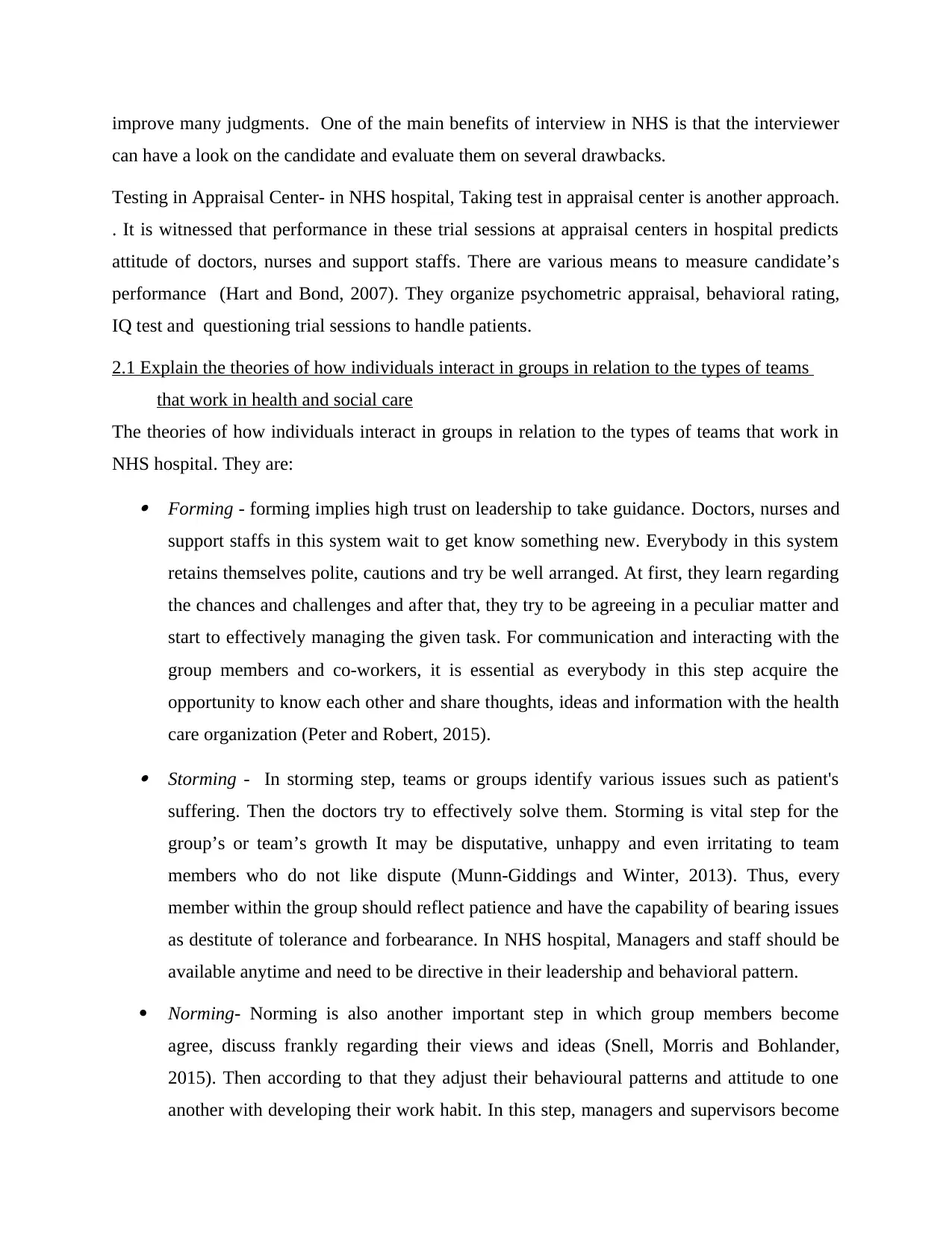
improve many judgments. One of the main benefits of interview in NHS is that the interviewer
can have a look on the candidate and evaluate them on several drawbacks.
Testing in Appraisal Center- in NHS hospital, Taking test in appraisal center is another approach.
. It is witnessed that performance in these trial sessions at appraisal centers in hospital predicts
attitude of doctors, nurses and support staffs. There are various means to measure candidate’s
performance (Hart and Bond, 2007). They organize psychometric appraisal, behavioral rating,
IQ test and questioning trial sessions to handle patients.
2.1 Explain the theories of how individuals interact in groups in relation to the types of teams
that work in health and social care
The theories of how individuals interact in groups in relation to the types of teams that work in
NHS hospital. They are: Forming - forming implies high trust on leadership to take guidance. Doctors, nurses and
support staffs in this system wait to get know something new. Everybody in this system
retains themselves polite, cautions and try be well arranged. At first, they learn regarding
the chances and challenges and after that, they try to be agreeing in a peculiar matter and
start to effectively managing the given task. For communication and interacting with the
group members and co-workers, it is essential as everybody in this step acquire the
opportunity to know each other and share thoughts, ideas and information with the health
care organization (Peter and Robert, 2015). Storming - In storming step, teams or groups identify various issues such as patient's
suffering. Then the doctors try to effectively solve them. Storming is vital step for the
group’s or team’s growth It may be disputative, unhappy and even irritating to team
members who do not like dispute (Munn-Giddings and Winter, 2013). Thus, every
member within the group should reflect patience and have the capability of bearing issues
as destitute of tolerance and forbearance. In NHS hospital, Managers and staff should be
available anytime and need to be directive in their leadership and behavioral pattern.
Norming- Norming is also another important step in which group members become
agree, discuss frankly regarding their views and ideas (Snell, Morris and Bohlander,
2015). Then according to that they adjust their behavioural patterns and attitude to one
another with developing their work habit. In this step, managers and supervisors become
can have a look on the candidate and evaluate them on several drawbacks.
Testing in Appraisal Center- in NHS hospital, Taking test in appraisal center is another approach.
. It is witnessed that performance in these trial sessions at appraisal centers in hospital predicts
attitude of doctors, nurses and support staffs. There are various means to measure candidate’s
performance (Hart and Bond, 2007). They organize psychometric appraisal, behavioral rating,
IQ test and questioning trial sessions to handle patients.
2.1 Explain the theories of how individuals interact in groups in relation to the types of teams
that work in health and social care
The theories of how individuals interact in groups in relation to the types of teams that work in
NHS hospital. They are: Forming - forming implies high trust on leadership to take guidance. Doctors, nurses and
support staffs in this system wait to get know something new. Everybody in this system
retains themselves polite, cautions and try be well arranged. At first, they learn regarding
the chances and challenges and after that, they try to be agreeing in a peculiar matter and
start to effectively managing the given task. For communication and interacting with the
group members and co-workers, it is essential as everybody in this step acquire the
opportunity to know each other and share thoughts, ideas and information with the health
care organization (Peter and Robert, 2015). Storming - In storming step, teams or groups identify various issues such as patient's
suffering. Then the doctors try to effectively solve them. Storming is vital step for the
group’s or team’s growth It may be disputative, unhappy and even irritating to team
members who do not like dispute (Munn-Giddings and Winter, 2013). Thus, every
member within the group should reflect patience and have the capability of bearing issues
as destitute of tolerance and forbearance. In NHS hospital, Managers and staff should be
available anytime and need to be directive in their leadership and behavioral pattern.
Norming- Norming is also another important step in which group members become
agree, discuss frankly regarding their views and ideas (Snell, Morris and Bohlander,
2015). Then according to that they adjust their behavioural patterns and attitude to one
another with developing their work habit. In this step, managers and supervisors become
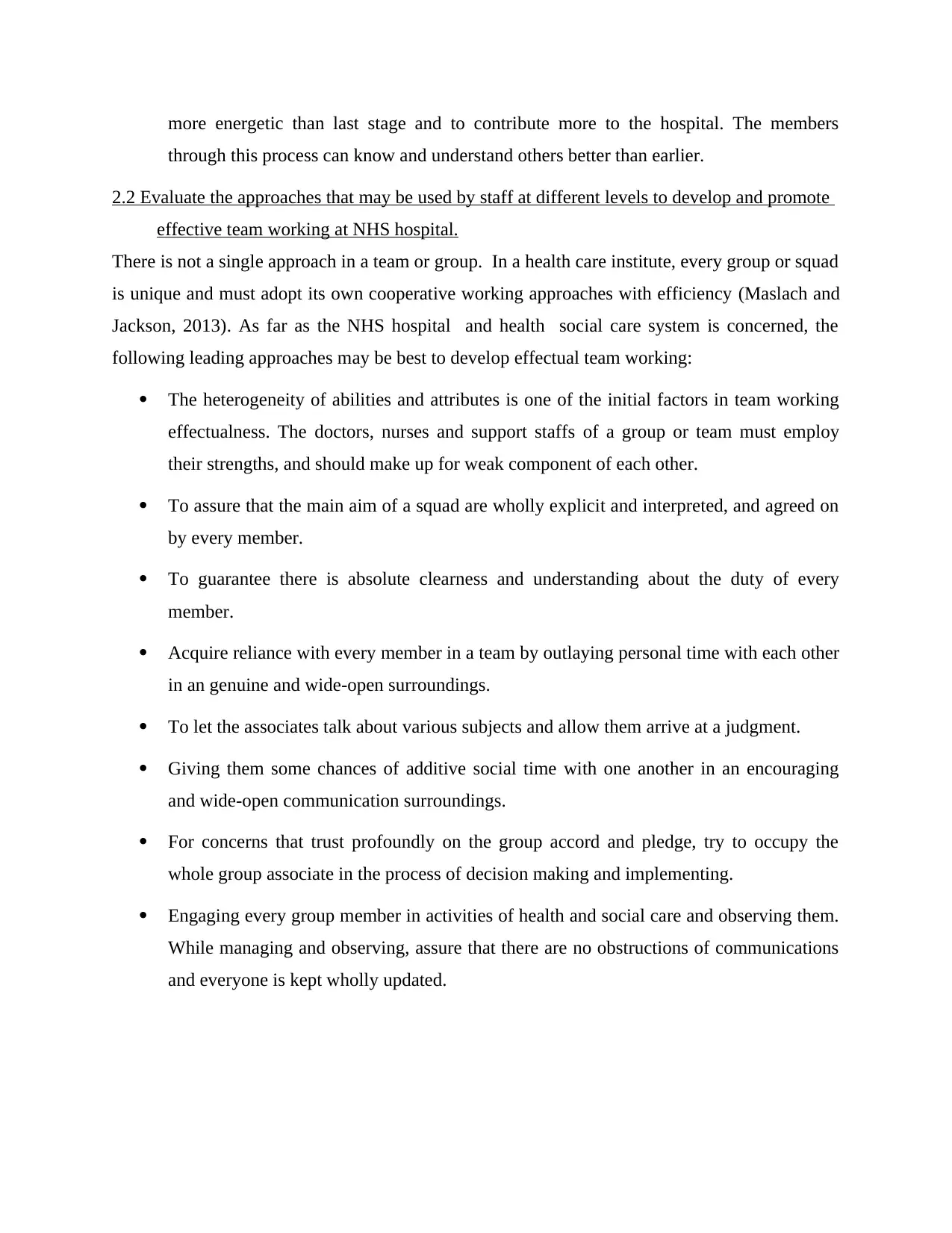
more energetic than last stage and to contribute more to the hospital. The members
through this process can know and understand others better than earlier.
2.2 Evaluate the approaches that may be used by staff at different levels to develop and promote
effective team working at NHS hospital.
There is not a single approach in a team or group. In a health care institute, every group or squad
is unique and must adopt its own cooperative working approaches with efficiency (Maslach and
Jackson, 2013). As far as the NHS hospital and health social care system is concerned, the
following leading approaches may be best to develop effectual team working:
The heterogeneity of abilities and attributes is one of the initial factors in team working
effectualness. The doctors, nurses and support staffs of a group or team must employ
their strengths, and should make up for weak component of each other.
To assure that the main aim of a squad are wholly explicit and interpreted, and agreed on
by every member.
To guarantee there is absolute clearness and understanding about the duty of every
member.
Acquire reliance with every member in a team by outlaying personal time with each other
in an genuine and wide-open surroundings.
To let the associates talk about various subjects and allow them arrive at a judgment.
Giving them some chances of additive social time with one another in an encouraging
and wide-open communication surroundings.
For concerns that trust profoundly on the group accord and pledge, try to occupy the
whole group associate in the process of decision making and implementing.
Engaging every group member in activities of health and social care and observing them.
While managing and observing, assure that there are no obstructions of communications
and everyone is kept wholly updated.
through this process can know and understand others better than earlier.
2.2 Evaluate the approaches that may be used by staff at different levels to develop and promote
effective team working at NHS hospital.
There is not a single approach in a team or group. In a health care institute, every group or squad
is unique and must adopt its own cooperative working approaches with efficiency (Maslach and
Jackson, 2013). As far as the NHS hospital and health social care system is concerned, the
following leading approaches may be best to develop effectual team working:
The heterogeneity of abilities and attributes is one of the initial factors in team working
effectualness. The doctors, nurses and support staffs of a group or team must employ
their strengths, and should make up for weak component of each other.
To assure that the main aim of a squad are wholly explicit and interpreted, and agreed on
by every member.
To guarantee there is absolute clearness and understanding about the duty of every
member.
Acquire reliance with every member in a team by outlaying personal time with each other
in an genuine and wide-open surroundings.
To let the associates talk about various subjects and allow them arrive at a judgment.
Giving them some chances of additive social time with one another in an encouraging
and wide-open communication surroundings.
For concerns that trust profoundly on the group accord and pledge, try to occupy the
whole group associate in the process of decision making and implementing.
Engaging every group member in activities of health and social care and observing them.
While managing and observing, assure that there are no obstructions of communications
and everyone is kept wholly updated.
⊘ This is a preview!⊘
Do you want full access?
Subscribe today to unlock all pages.

Trusted by 1+ million students worldwide
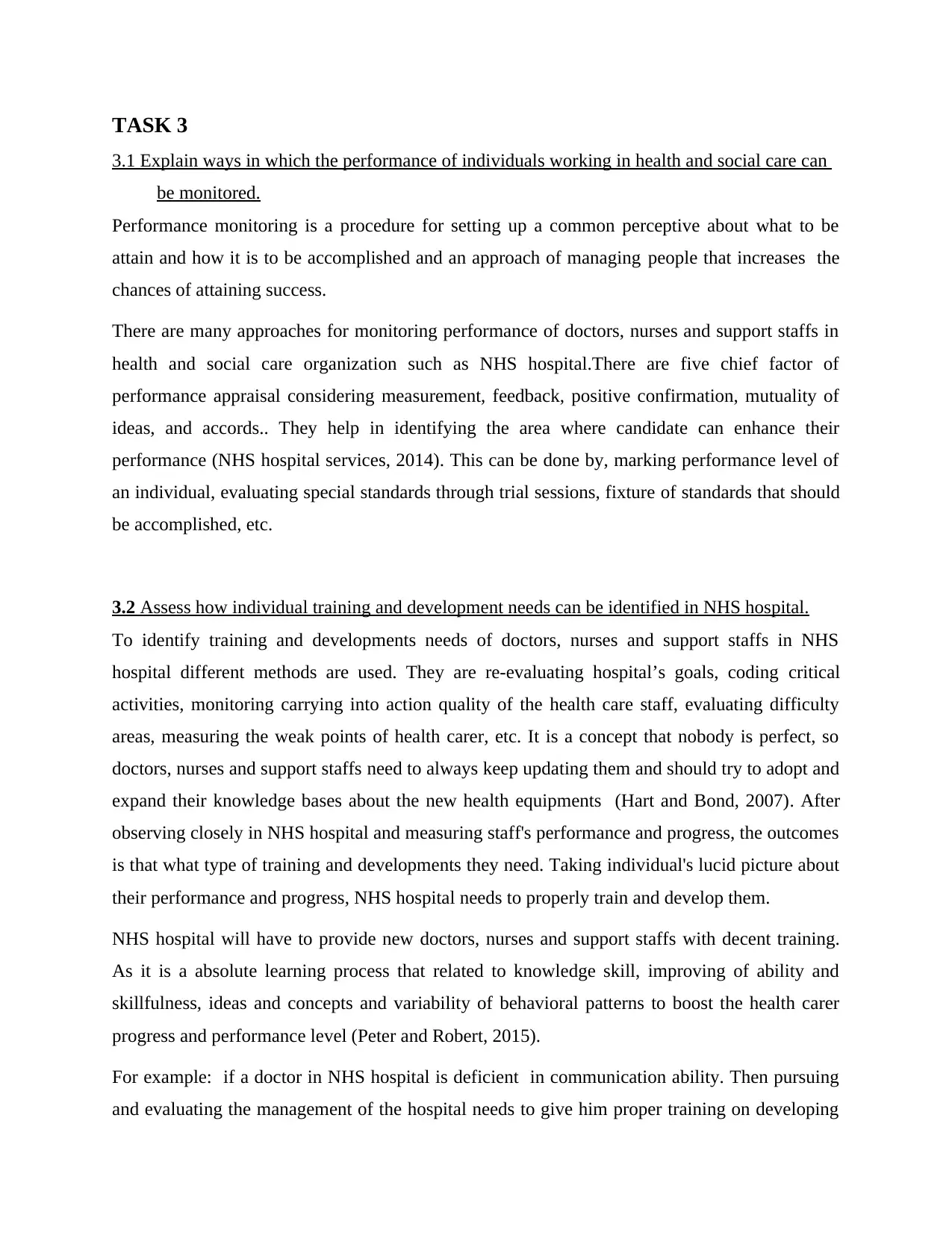
TASK 3
3.1 Explain ways in which the performance of individuals working in health and social care can
be monitored.
Performance monitoring is a procedure for setting up a common perceptive about what to be
attain and how it is to be accomplished and an approach of managing people that increases the
chances of attaining success.
There are many approaches for monitoring performance of doctors, nurses and support staffs in
health and social care organization such as NHS hospital.There are five chief factor of
performance appraisal considering measurement, feedback, positive confirmation, mutuality of
ideas, and accords.. They help in identifying the area where candidate can enhance their
performance (NHS hospital services, 2014). This can be done by, marking performance level of
an individual, evaluating special standards through trial sessions, fixture of standards that should
be accomplished, etc.
3.2 Assess how individual training and development needs can be identified in NHS hospital.
To identify training and developments needs of doctors, nurses and support staffs in NHS
hospital different methods are used. They are re-evaluating hospital’s goals, coding critical
activities, monitoring carrying into action quality of the health care staff, evaluating difficulty
areas, measuring the weak points of health carer, etc. It is a concept that nobody is perfect, so
doctors, nurses and support staffs need to always keep updating them and should try to adopt and
expand their knowledge bases about the new health equipments (Hart and Bond, 2007). After
observing closely in NHS hospital and measuring staff's performance and progress, the outcomes
is that what type of training and developments they need. Taking individual's lucid picture about
their performance and progress, NHS hospital needs to properly train and develop them.
NHS hospital will have to provide new doctors, nurses and support staffs with decent training.
As it is a absolute learning process that related to knowledge skill, improving of ability and
skillfulness, ideas and concepts and variability of behavioral patterns to boost the health carer
progress and performance level (Peter and Robert, 2015).
For example: if a doctor in NHS hospital is deficient in communication ability. Then pursuing
and evaluating the management of the hospital needs to give him proper training on developing
3.1 Explain ways in which the performance of individuals working in health and social care can
be monitored.
Performance monitoring is a procedure for setting up a common perceptive about what to be
attain and how it is to be accomplished and an approach of managing people that increases the
chances of attaining success.
There are many approaches for monitoring performance of doctors, nurses and support staffs in
health and social care organization such as NHS hospital.There are five chief factor of
performance appraisal considering measurement, feedback, positive confirmation, mutuality of
ideas, and accords.. They help in identifying the area where candidate can enhance their
performance (NHS hospital services, 2014). This can be done by, marking performance level of
an individual, evaluating special standards through trial sessions, fixture of standards that should
be accomplished, etc.
3.2 Assess how individual training and development needs can be identified in NHS hospital.
To identify training and developments needs of doctors, nurses and support staffs in NHS
hospital different methods are used. They are re-evaluating hospital’s goals, coding critical
activities, monitoring carrying into action quality of the health care staff, evaluating difficulty
areas, measuring the weak points of health carer, etc. It is a concept that nobody is perfect, so
doctors, nurses and support staffs need to always keep updating them and should try to adopt and
expand their knowledge bases about the new health equipments (Hart and Bond, 2007). After
observing closely in NHS hospital and measuring staff's performance and progress, the outcomes
is that what type of training and developments they need. Taking individual's lucid picture about
their performance and progress, NHS hospital needs to properly train and develop them.
NHS hospital will have to provide new doctors, nurses and support staffs with decent training.
As it is a absolute learning process that related to knowledge skill, improving of ability and
skillfulness, ideas and concepts and variability of behavioral patterns to boost the health carer
progress and performance level (Peter and Robert, 2015).
For example: if a doctor in NHS hospital is deficient in communication ability. Then pursuing
and evaluating the management of the hospital needs to give him proper training on developing
Paraphrase This Document
Need a fresh take? Get an instant paraphrase of this document with our AI Paraphraser
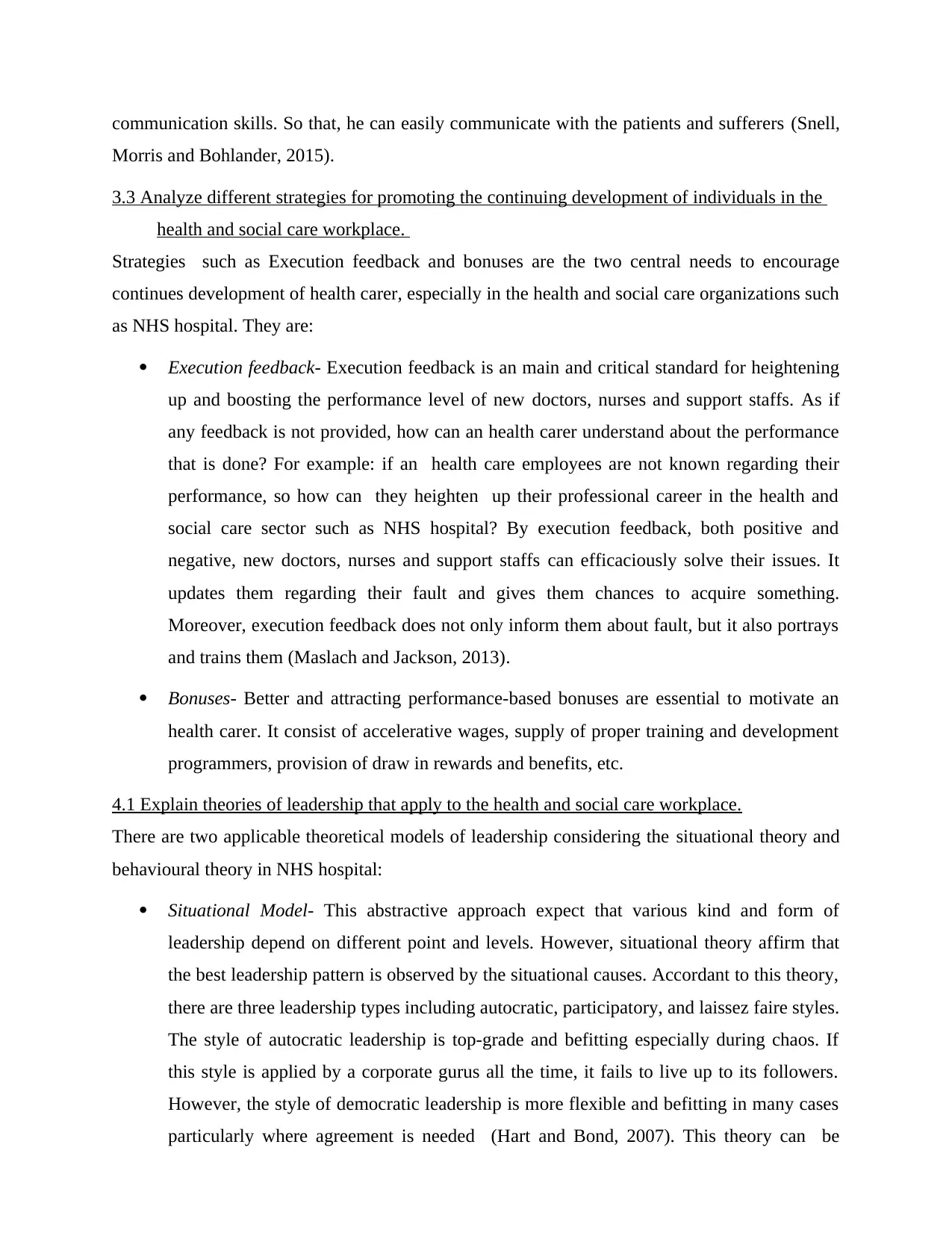
communication skills. So that, he can easily communicate with the patients and sufferers (Snell,
Morris and Bohlander, 2015).
3.3 Analyze different strategies for promoting the continuing development of individuals in the
health and social care workplace.
Strategies such as Execution feedback and bonuses are the two central needs to encourage
continues development of health carer, especially in the health and social care organizations such
as NHS hospital. They are:
Execution feedback- Execution feedback is an main and critical standard for heightening
up and boosting the performance level of new doctors, nurses and support staffs. As if
any feedback is not provided, how can an health carer understand about the performance
that is done? For example: if an health care employees are not known regarding their
performance, so how can they heighten up their professional career in the health and
social care sector such as NHS hospital? By execution feedback, both positive and
negative, new doctors, nurses and support staffs can efficaciously solve their issues. It
updates them regarding their fault and gives them chances to acquire something.
Moreover, execution feedback does not only inform them about fault, but it also portrays
and trains them (Maslach and Jackson, 2013).
Bonuses- Better and attracting performance-based bonuses are essential to motivate an
health carer. It consist of accelerative wages, supply of proper training and development
programmers, provision of draw in rewards and benefits, etc.
4.1 Explain theories of leadership that apply to the health and social care workplace.
There are two applicable theoretical models of leadership considering the situational theory and
behavioural theory in NHS hospital:
Situational Model- This abstractive approach expect that various kind and form of
leadership depend on different point and levels. However, situational theory affirm that
the best leadership pattern is observed by the situational causes. Accordant to this theory,
there are three leadership types including autocratic, participatory, and laissez faire styles.
The style of autocratic leadership is top-grade and befitting especially during chaos. If
this style is applied by a corporate gurus all the time, it fails to live up to its followers.
However, the style of democratic leadership is more flexible and befitting in many cases
particularly where agreement is needed (Hart and Bond, 2007). This theory can be
Morris and Bohlander, 2015).
3.3 Analyze different strategies for promoting the continuing development of individuals in the
health and social care workplace.
Strategies such as Execution feedback and bonuses are the two central needs to encourage
continues development of health carer, especially in the health and social care organizations such
as NHS hospital. They are:
Execution feedback- Execution feedback is an main and critical standard for heightening
up and boosting the performance level of new doctors, nurses and support staffs. As if
any feedback is not provided, how can an health carer understand about the performance
that is done? For example: if an health care employees are not known regarding their
performance, so how can they heighten up their professional career in the health and
social care sector such as NHS hospital? By execution feedback, both positive and
negative, new doctors, nurses and support staffs can efficaciously solve their issues. It
updates them regarding their fault and gives them chances to acquire something.
Moreover, execution feedback does not only inform them about fault, but it also portrays
and trains them (Maslach and Jackson, 2013).
Bonuses- Better and attracting performance-based bonuses are essential to motivate an
health carer. It consist of accelerative wages, supply of proper training and development
programmers, provision of draw in rewards and benefits, etc.
4.1 Explain theories of leadership that apply to the health and social care workplace.
There are two applicable theoretical models of leadership considering the situational theory and
behavioural theory in NHS hospital:
Situational Model- This abstractive approach expect that various kind and form of
leadership depend on different point and levels. However, situational theory affirm that
the best leadership pattern is observed by the situational causes. Accordant to this theory,
there are three leadership types including autocratic, participatory, and laissez faire styles.
The style of autocratic leadership is top-grade and befitting especially during chaos. If
this style is applied by a corporate gurus all the time, it fails to live up to its followers.
However, the style of democratic leadership is more flexible and befitting in many cases
particularly where agreement is needed (Hart and Bond, 2007). This theory can be
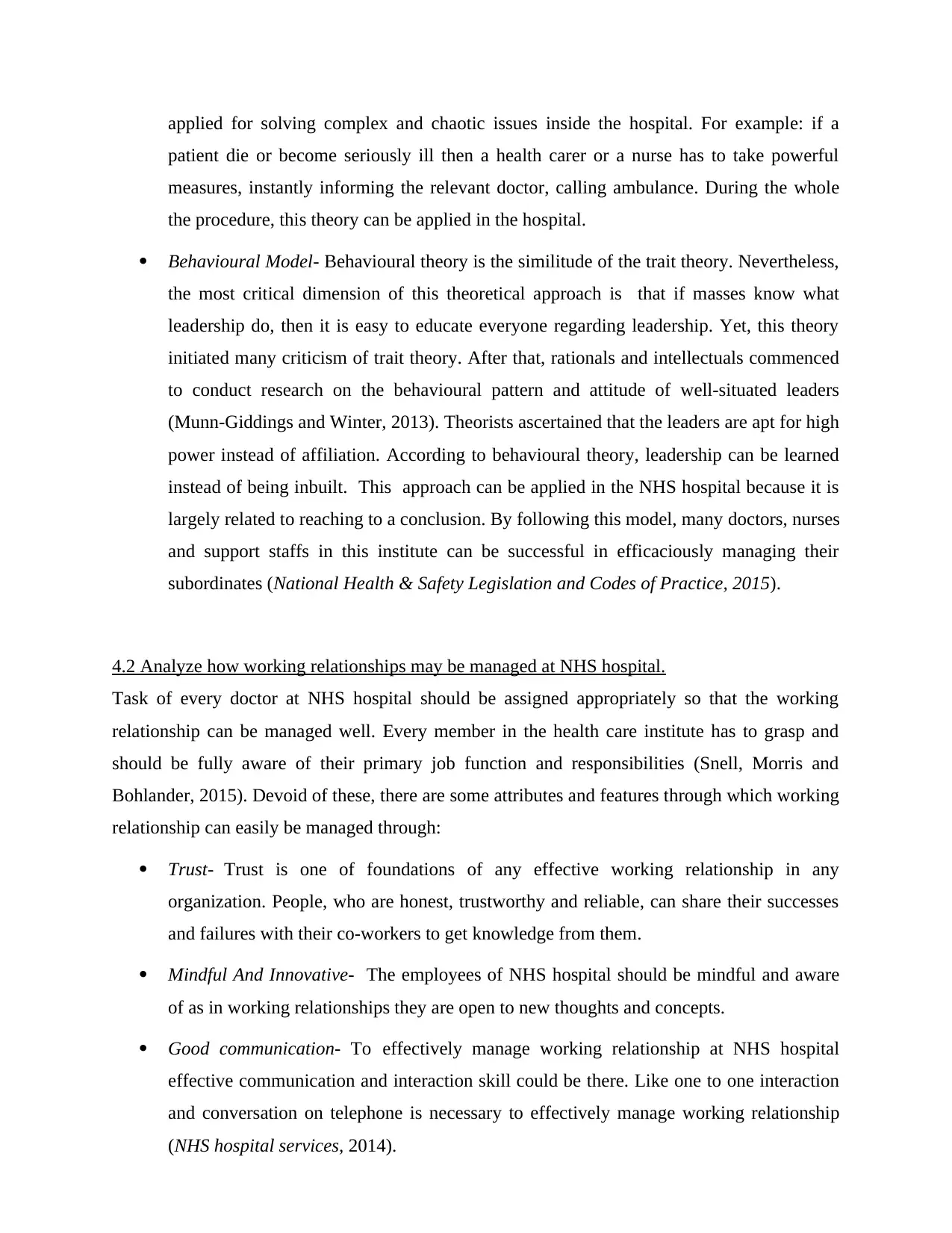
applied for solving complex and chaotic issues inside the hospital. For example: if a
patient die or become seriously ill then a health carer or a nurse has to take powerful
measures, instantly informing the relevant doctor, calling ambulance. During the whole
the procedure, this theory can be applied in the hospital.
Behavioural Model- Behavioural theory is the similitude of the trait theory. Nevertheless,
the most critical dimension of this theoretical approach is that if masses know what
leadership do, then it is easy to educate everyone regarding leadership. Yet, this theory
initiated many criticism of trait theory. After that, rationals and intellectuals commenced
to conduct research on the behavioural pattern and attitude of well-situated leaders
(Munn-Giddings and Winter, 2013). Theorists ascertained that the leaders are apt for high
power instead of affiliation. According to behavioural theory, leadership can be learned
instead of being inbuilt. This approach can be applied in the NHS hospital because it is
largely related to reaching to a conclusion. By following this model, many doctors, nurses
and support staffs in this institute can be successful in efficaciously managing their
subordinates (National Health & Safety Legislation and Codes of Practice, 2015).
4.2 Analyze how working relationships may be managed at NHS hospital.
Task of every doctor at NHS hospital should be assigned appropriately so that the working
relationship can be managed well. Every member in the health care institute has to grasp and
should be fully aware of their primary job function and responsibilities (Snell, Morris and
Bohlander, 2015). Devoid of these, there are some attributes and features through which working
relationship can easily be managed through:
Trust- Trust is one of foundations of any effective working relationship in any
organization. People, who are honest, trustworthy and reliable, can share their successes
and failures with their co-workers to get knowledge from them.
Mindful And Innovative- The employees of NHS hospital should be mindful and aware
of as in working relationships they are open to new thoughts and concepts.
Good communication- To effectively manage working relationship at NHS hospital
effective communication and interaction skill could be there. Like one to one interaction
and conversation on telephone is necessary to effectively manage working relationship
(NHS hospital services, 2014).
patient die or become seriously ill then a health carer or a nurse has to take powerful
measures, instantly informing the relevant doctor, calling ambulance. During the whole
the procedure, this theory can be applied in the hospital.
Behavioural Model- Behavioural theory is the similitude of the trait theory. Nevertheless,
the most critical dimension of this theoretical approach is that if masses know what
leadership do, then it is easy to educate everyone regarding leadership. Yet, this theory
initiated many criticism of trait theory. After that, rationals and intellectuals commenced
to conduct research on the behavioural pattern and attitude of well-situated leaders
(Munn-Giddings and Winter, 2013). Theorists ascertained that the leaders are apt for high
power instead of affiliation. According to behavioural theory, leadership can be learned
instead of being inbuilt. This approach can be applied in the NHS hospital because it is
largely related to reaching to a conclusion. By following this model, many doctors, nurses
and support staffs in this institute can be successful in efficaciously managing their
subordinates (National Health & Safety Legislation and Codes of Practice, 2015).
4.2 Analyze how working relationships may be managed at NHS hospital.
Task of every doctor at NHS hospital should be assigned appropriately so that the working
relationship can be managed well. Every member in the health care institute has to grasp and
should be fully aware of their primary job function and responsibilities (Snell, Morris and
Bohlander, 2015). Devoid of these, there are some attributes and features through which working
relationship can easily be managed through:
Trust- Trust is one of foundations of any effective working relationship in any
organization. People, who are honest, trustworthy and reliable, can share their successes
and failures with their co-workers to get knowledge from them.
Mindful And Innovative- The employees of NHS hospital should be mindful and aware
of as in working relationships they are open to new thoughts and concepts.
Good communication- To effectively manage working relationship at NHS hospital
effective communication and interaction skill could be there. Like one to one interaction
and conversation on telephone is necessary to effectively manage working relationship
(NHS hospital services, 2014).
⊘ This is a preview!⊘
Do you want full access?
Subscribe today to unlock all pages.

Trusted by 1+ million students worldwide
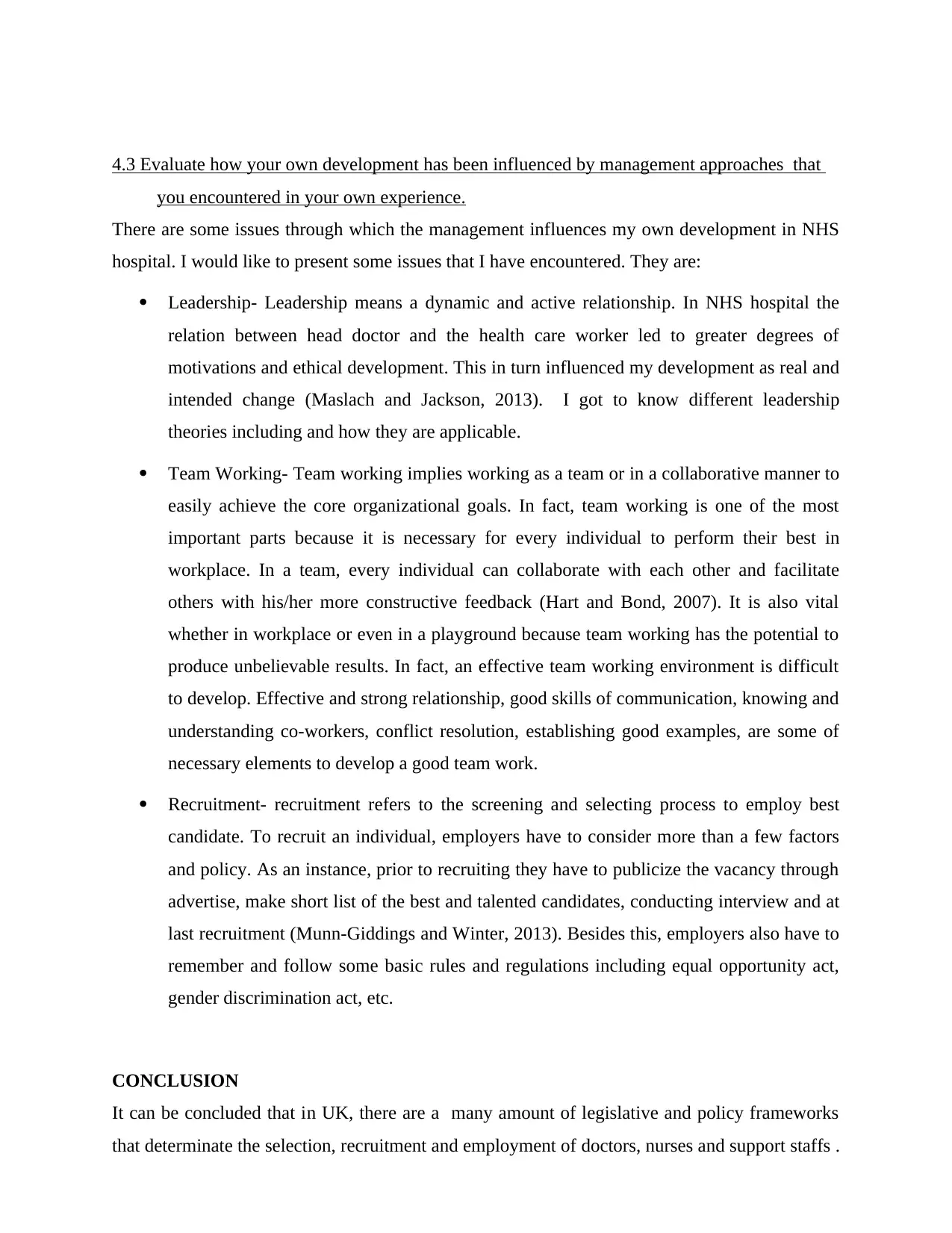
4.3 Evaluate how your own development has been influenced by management approaches that
you encountered in your own experience.
There are some issues through which the management influences my own development in NHS
hospital. I would like to present some issues that I have encountered. They are:
Leadership- Leadership means a dynamic and active relationship. In NHS hospital the
relation between head doctor and the health care worker led to greater degrees of
motivations and ethical development. This in turn influenced my development as real and
intended change (Maslach and Jackson, 2013). I got to know different leadership
theories including and how they are applicable.
Team Working- Team working implies working as a team or in a collaborative manner to
easily achieve the core organizational goals. In fact, team working is one of the most
important parts because it is necessary for every individual to perform their best in
workplace. In a team, every individual can collaborate with each other and facilitate
others with his/her more constructive feedback (Hart and Bond, 2007). It is also vital
whether in workplace or even in a playground because team working has the potential to
produce unbelievable results. In fact, an effective team working environment is difficult
to develop. Effective and strong relationship, good skills of communication, knowing and
understanding co-workers, conflict resolution, establishing good examples, are some of
necessary elements to develop a good team work.
Recruitment- recruitment refers to the screening and selecting process to employ best
candidate. To recruit an individual, employers have to consider more than a few factors
and policy. As an instance, prior to recruiting they have to publicize the vacancy through
advertise, make short list of the best and talented candidates, conducting interview and at
last recruitment (Munn-Giddings and Winter, 2013). Besides this, employers also have to
remember and follow some basic rules and regulations including equal opportunity act,
gender discrimination act, etc.
CONCLUSION
It can be concluded that in UK, there are a many amount of legislative and policy frameworks
that determinate the selection, recruitment and employment of doctors, nurses and support staffs .
you encountered in your own experience.
There are some issues through which the management influences my own development in NHS
hospital. I would like to present some issues that I have encountered. They are:
Leadership- Leadership means a dynamic and active relationship. In NHS hospital the
relation between head doctor and the health care worker led to greater degrees of
motivations and ethical development. This in turn influenced my development as real and
intended change (Maslach and Jackson, 2013). I got to know different leadership
theories including and how they are applicable.
Team Working- Team working implies working as a team or in a collaborative manner to
easily achieve the core organizational goals. In fact, team working is one of the most
important parts because it is necessary for every individual to perform their best in
workplace. In a team, every individual can collaborate with each other and facilitate
others with his/her more constructive feedback (Hart and Bond, 2007). It is also vital
whether in workplace or even in a playground because team working has the potential to
produce unbelievable results. In fact, an effective team working environment is difficult
to develop. Effective and strong relationship, good skills of communication, knowing and
understanding co-workers, conflict resolution, establishing good examples, are some of
necessary elements to develop a good team work.
Recruitment- recruitment refers to the screening and selecting process to employ best
candidate. To recruit an individual, employers have to consider more than a few factors
and policy. As an instance, prior to recruiting they have to publicize the vacancy through
advertise, make short list of the best and talented candidates, conducting interview and at
last recruitment (Munn-Giddings and Winter, 2013). Besides this, employers also have to
remember and follow some basic rules and regulations including equal opportunity act,
gender discrimination act, etc.
CONCLUSION
It can be concluded that in UK, there are a many amount of legislative and policy frameworks
that determinate the selection, recruitment and employment of doctors, nurses and support staffs .
Paraphrase This Document
Need a fresh take? Get an instant paraphrase of this document with our AI Paraphraser
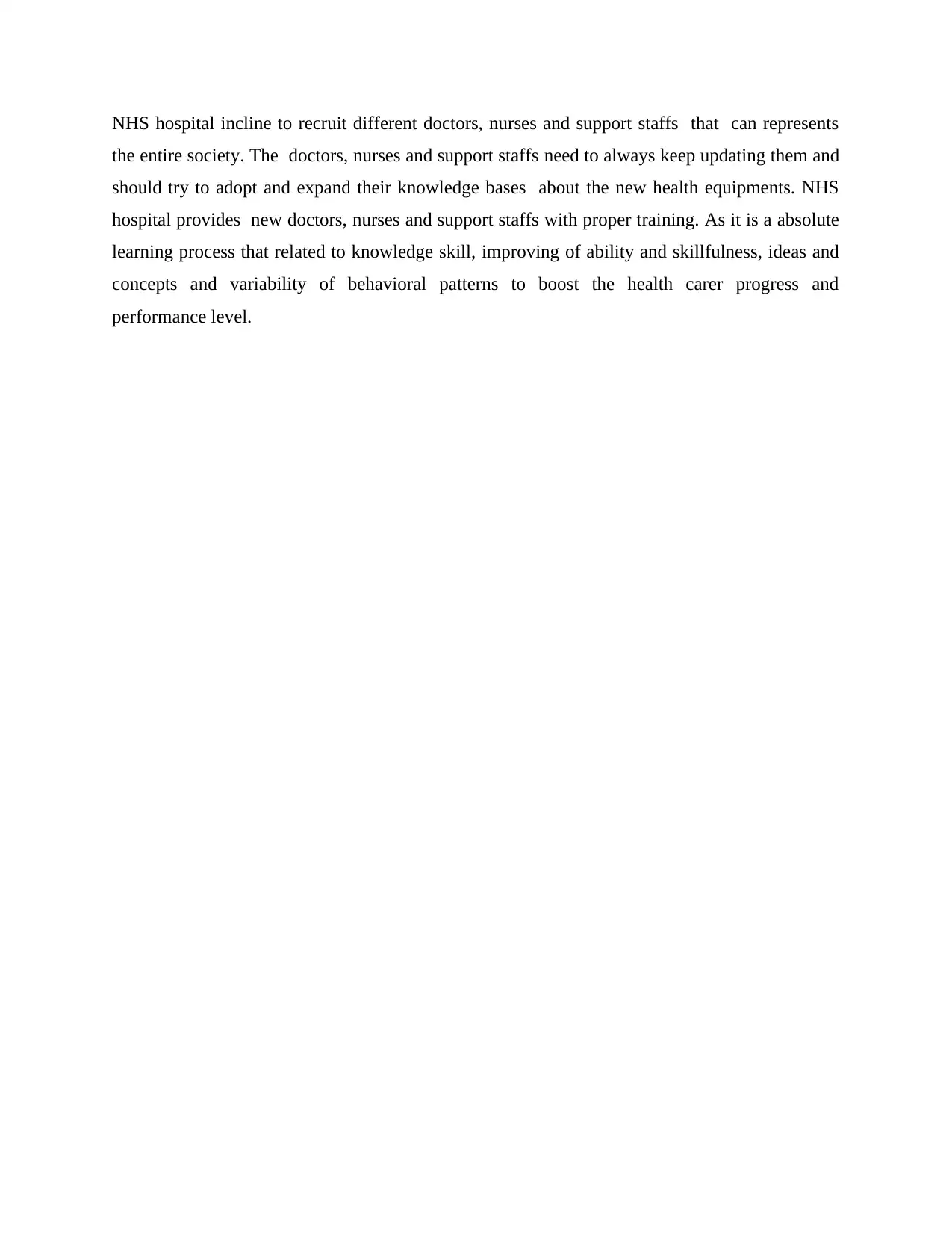
NHS hospital incline to recruit different doctors, nurses and support staffs that can represents
the entire society. The doctors, nurses and support staffs need to always keep updating them and
should try to adopt and expand their knowledge bases about the new health equipments. NHS
hospital provides new doctors, nurses and support staffs with proper training. As it is a absolute
learning process that related to knowledge skill, improving of ability and skillfulness, ideas and
concepts and variability of behavioral patterns to boost the health carer progress and
performance level.
the entire society. The doctors, nurses and support staffs need to always keep updating them and
should try to adopt and expand their knowledge bases about the new health equipments. NHS
hospital provides new doctors, nurses and support staffs with proper training. As it is a absolute
learning process that related to knowledge skill, improving of ability and skillfulness, ideas and
concepts and variability of behavioral patterns to boost the health carer progress and
performance level.
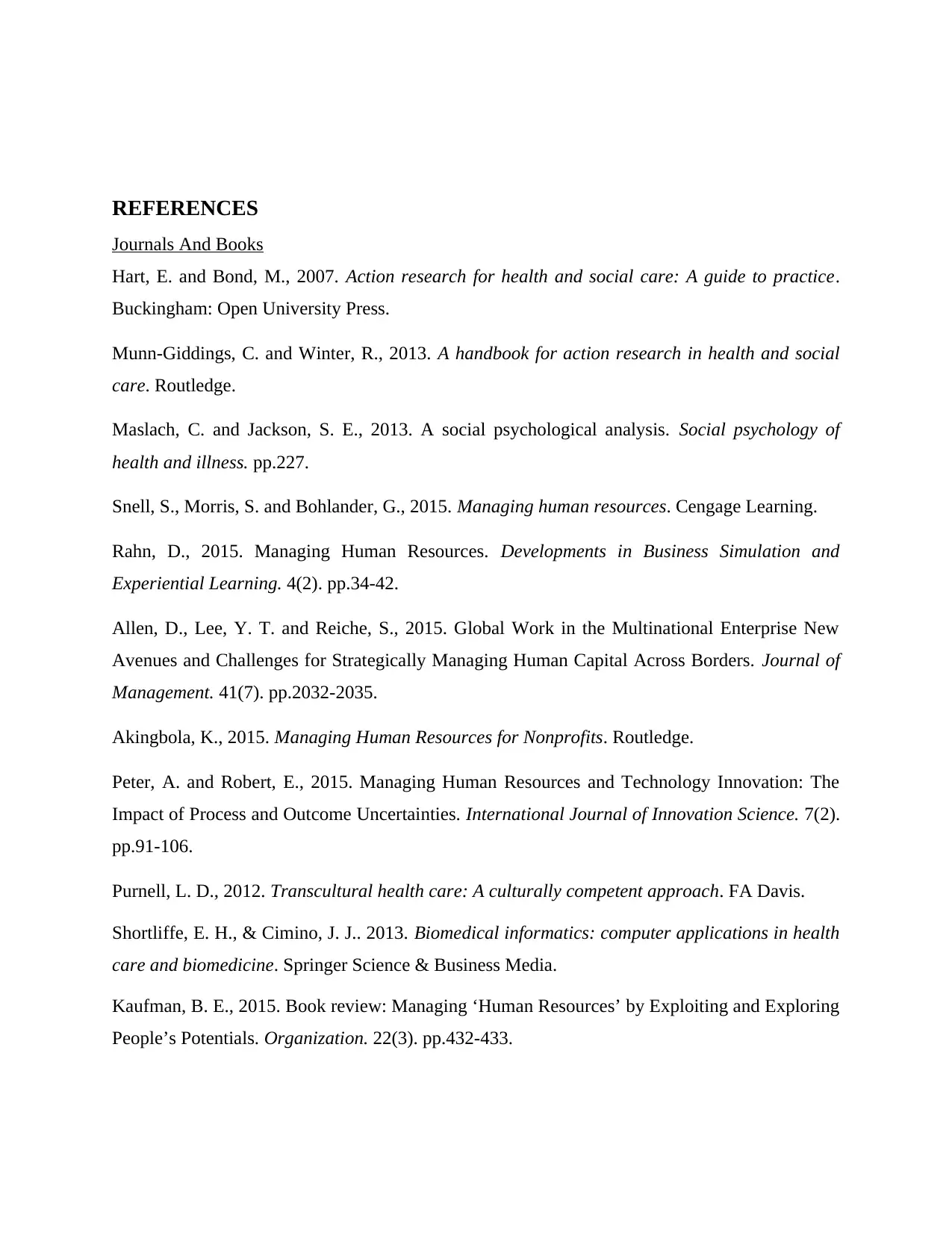
REFERENCES
Journals And Books
Hart, E. and Bond, M., 2007. Action research for health and social care: A guide to practice.
Buckingham: Open University Press.
Munn-Giddings, C. and Winter, R., 2013. A handbook for action research in health and social
care. Routledge.
Maslach, C. and Jackson, S. E., 2013. A social psychological analysis. Social psychology of
health and illness. pp.227.
Snell, S., Morris, S. and Bohlander, G., 2015. Managing human resources. Cengage Learning.
Rahn, D., 2015. Managing Human Resources. Developments in Business Simulation and
Experiential Learning. 4(2). pp.34-42.
Allen, D., Lee, Y. T. and Reiche, S., 2015. Global Work in the Multinational Enterprise New
Avenues and Challenges for Strategically Managing Human Capital Across Borders. Journal of
Management. 41(7). pp.2032-2035.
Akingbola, K., 2015. Managing Human Resources for Nonprofits. Routledge.
Peter, A. and Robert, E., 2015. Managing Human Resources and Technology Innovation: The
Impact of Process and Outcome Uncertainties. International Journal of Innovation Science. 7(2).
pp.91-106.
Purnell, L. D., 2012. Transcultural health care: A culturally competent approach. FA Davis.
Shortliffe, E. H., & Cimino, J. J.. 2013. Biomedical informatics: computer applications in health
care and biomedicine. Springer Science & Business Media.
Kaufman, B. E., 2015. Book review: Managing ‘Human Resources’ by Exploiting and Exploring
People’s Potentials. Organization. 22(3). pp.432-433.
Journals And Books
Hart, E. and Bond, M., 2007. Action research for health and social care: A guide to practice.
Buckingham: Open University Press.
Munn-Giddings, C. and Winter, R., 2013. A handbook for action research in health and social
care. Routledge.
Maslach, C. and Jackson, S. E., 2013. A social psychological analysis. Social psychology of
health and illness. pp.227.
Snell, S., Morris, S. and Bohlander, G., 2015. Managing human resources. Cengage Learning.
Rahn, D., 2015. Managing Human Resources. Developments in Business Simulation and
Experiential Learning. 4(2). pp.34-42.
Allen, D., Lee, Y. T. and Reiche, S., 2015. Global Work in the Multinational Enterprise New
Avenues and Challenges for Strategically Managing Human Capital Across Borders. Journal of
Management. 41(7). pp.2032-2035.
Akingbola, K., 2015. Managing Human Resources for Nonprofits. Routledge.
Peter, A. and Robert, E., 2015. Managing Human Resources and Technology Innovation: The
Impact of Process and Outcome Uncertainties. International Journal of Innovation Science. 7(2).
pp.91-106.
Purnell, L. D., 2012. Transcultural health care: A culturally competent approach. FA Davis.
Shortliffe, E. H., & Cimino, J. J.. 2013. Biomedical informatics: computer applications in health
care and biomedicine. Springer Science & Business Media.
Kaufman, B. E., 2015. Book review: Managing ‘Human Resources’ by Exploiting and Exploring
People’s Potentials. Organization. 22(3). pp.432-433.
⊘ This is a preview!⊘
Do you want full access?
Subscribe today to unlock all pages.

Trusted by 1+ million students worldwide
1 out of 16
Related Documents
Your All-in-One AI-Powered Toolkit for Academic Success.
+13062052269
info@desklib.com
Available 24*7 on WhatsApp / Email
![[object Object]](/_next/static/media/star-bottom.7253800d.svg)
Unlock your academic potential
Copyright © 2020–2025 A2Z Services. All Rights Reserved. Developed and managed by ZUCOL.





